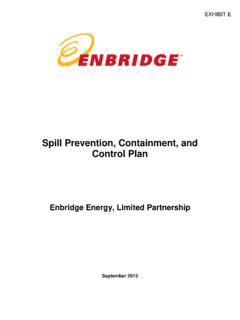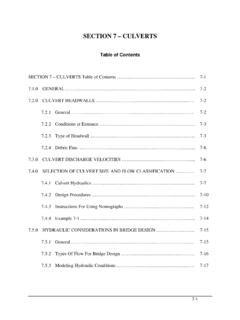Transcription of SEDIMENT AND EROSION CONTROL GUIDELINES FOR …
1 ARMY CORPS OF ENGINEERS Little Rock District SSEEDDIIMMEENNTT AANNDD EERROOSSIIOONN CCOONNTTRROOLL GGUUIIDDEELLIINNEESS FFOORR PPIIPPEELLIINNEE PPRROOJJEECCTTSS Table of Contents INTRODUCTION .. - 1 - PROJECTS IN WATERS OF THE UNITED STATES .. - 1 - STREAM AND RIVER CROSSINGS .. - 1 - WETLAND CROSSINGS .. - 3 - SEDIMENTATION AND EROSION CONTROL .. - 3 - TEMPORARY MEASURES .. - 4 - SEDIMENT BARRIERS .. - 4 - INTERCEPTOR DIKES .. - 5 - TRENCH PLUGS (Breakers) .. - 6 - TRENCH DEWATERING .. - 6 - DIVERSION DITCHES .. - 6 - SEDIMENT BASINS .. - 6 - FLEXIBLE DOWNDRAINS .. - 7 - NONVEGETATIVE SOIL STABILIZATION.
2 - 7 - TEMPORARY SEEDING AND REVEGETATION .. - 8 - PERMANENT RESTORATION MEASURES .. - 8 - APPENDIX FIGURE - 10 - FIGURE - 11 - FIGURE - 12 - FIGURE - 13 - FIGURE - 14 - FIGURE - 15 - FIGURE - 16 - FIGURE - 17 - FIGURE - 18 - FIGURE - 19 - FIGURE - 20 - FIGURE - 21 - FIGURE - 22 - FIGURE - 5 - - 1 - SEDIMENTATION AMD EROSION CONTROL GUIDELINES FOR PIPELINE PROJECTS INTRODUCTION The following Sedimentation and EROSION CONTROL GUIDELINES are based upon acceptable practices in the Little Rock District, Army Corps of Engineers. All pipeline projects crossing waters of the United States in the Little Rock District shall be constructed using these GUIDELINES .
3 These practices include constructing temporary and permanent EROSION and sedimentation CONTROL devices properly; stabilizing earthwork; seeding and sedimentation CONTROL devices; and maintaining these until the land is permanently stabilized. One of the most important EROSION and sedimentation CONTROL considerations is construction time frame. The time between initial disturbances and post construction stabilization is a critical element in minimizing adverse impacts to the environment. PROJECTS IN WATERS OF THE UNITED STATES Pipeline projects crossing waters of the United States are subject to regulation under Section 10 of the Rivers and Harbors Act of 1899 and Section 404 of the Clean Water Act.
4 Section 10 requires permits to authorize certain structures or work in or affecting navigable waters of the United States. Section 404 requires permits for the discharge of dredged or fill materials into waters of the United States. Wetlands are considered waters of the United States and also require Section 404 permits for crossings. The area of pipeline projects which must maintain EROSION CONTROL in connection with Department of the Army permits are all crossings of waters of the United States and the slopes which drain directly to the waterway. STREAM AND RIVER CROSSINGS During construction, various preventative measures may be implemented to reduce and minimize impacts to stream and river environments.
5 This section will present the conventional methods and techniques that will be used when crossing streams, rivers, and wetlands. For pipeline crossings of streams or creeks utilizing conventional open-cut trenching techniques, two (2) plans are proposed for SEDIMENT CONTROL in the stream or creek bed. Plan #1 is used when streams are small and perhaps intermittent, usually these streams are not considered navigable. Plan #2 is used when a stream has greater velocities and the flow must be maintained. It is used on streams/creeks that are considered navigable by the Army Corps of Engineers. - 2 - Plan #1 is proposed when the stream bed has solid rock and silt or mud present.
6 This plan requires straw bales/silt screening be installed across the entire width of the stream downstream of the construction (trench) area. The straw bales/silt screenings are held in place by installing wire cables and or stakes downstream of the straw bales/silt screening. SEDIMENT controls are installed prior to any construction activities in the stream bed and remain in place until all construction activities in the stream bed are completed. All ground contours are returned to their original condition. Figures 1A and 1B (Appendix) illustrates Plan #1. If the flow of the stream is too swift to maintain silt screening, additional measures are required.
7 An effective method which can be used is a water dam. Water dams function like small cofferdams. They can be placed where it is necessary to stop, slow, or manage the movement of water. They are temporary barriers built of inner tubes of water contained within heavy duty tubing. It can be used virtually in all locations including remote and uneven terrain and does not contribute to sedimentation in the stream. Plan #2 is proposed when the stream has sufficient flow to prevent the implementation of silt screens across the entire width of the stream. This plan uses a turbidity curtain which is custom designed for the proposed work area. It may be used alone or as a SEDIMENT CONTROL encircling a cofferdam.
8 The turbidity curtain has a flotation boom and a weighted bottom load line which allows SEDIMENT to settle to the stream bed from the bank thus minimizing the impact of equipment in the stream. All ground contours are returned to their original condition. Figures 2A, 2B, and 2C (Appendix) depict turbidity curtains for Plan #2. If conventional trenching methods cannot be used, the directional drilling method may be used on major river and stream crossings and environmentally sensitive areas. When directional drilling is required as part of Department of the Army Permit, it shall be specified in the permit letter. This method of installing pipelines is well documented as having the least negative impact on environmentally sensitive areas and wetlands.
9 Plans for directional-drilled crossings shall include the location of boring sites and temporary work areas for welding line pipe, as well as the drilling rig and other necessary equipment. The area from the boring sites to the water s edge normally will not be disturbed; however, if clearing of this area is needed, and this area is a wetland, it will be done using hand tools. If dozers, graders or other mechanical equipment will be utilized in clearing, and if the area is a wetland, an additional Department of the Army permit is required for such clearing. Silt fencing will be erected near the river s bank to prohibit the introduction of silt or debris into the water.
10 Additional straw or hay bales will be incorporated to prevent introduction of silt or sedimentation from the boring sites into the water. Where the pipeline crosses a waterway either by the open-cut method or the directional drill method, straw bales and silt fencing will be used until the revegetation program has matured sufficiently to stop the flow of silt into the water. Silt fencing and hay bales will be erected prior to any other ground disturbing activity. Fences and silt barrier hay bales will be maintained and remain in place as long as required to minimize any negative impacts on water quality. Permanent revegetation will proceed as rapidly as possible after pipeline operations are completed at the crossings.






